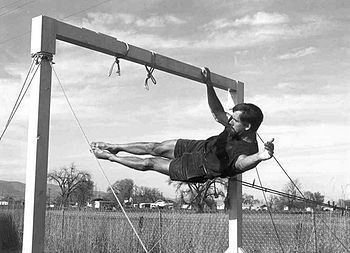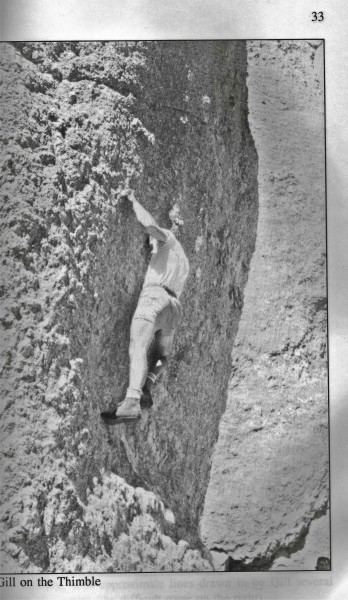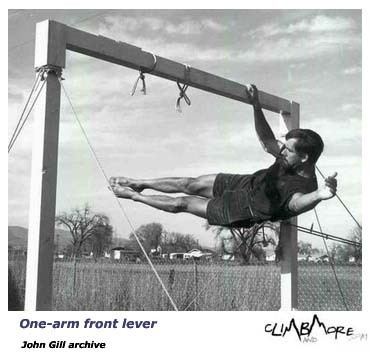Nationality American Role Rock climber | Name John Gill Type of climber Bouldering | |
 | ||
John gill bouldering at age 45 from on the rocks movie
John Gill (born 1937) is an American mathematician who has achieved recognition for his rock-climbing. He is considered the Father of Modern Bouldering by many climbers.
Contents
- John gill bouldering at age 45 from on the rocks movie
- 2013 john gill exercising a
- Early life and professional career
- Bouldering chalk controlled dynamics gymnastic style
- Early climbs
- Grading system for bouldering
- Gymnastics and strength exercises
- Historical research
- Mathematical research highlights
- References

2013 john gill exercising a
Early life and professional career

As a child, Gill lived in several Southern cities, including Atlanta, Georgia, where he graduated from Bass High Schoo in 1954 and attended Georgia Tech 1954-1956. He graduated from the University of Georgia with a degree in mathematics in 1958, and entered the USAF as a second lieutenant. He attended a special graduate meteorology program at the University of Chicago 1958-1959, then was assigned to Glasgow AFB, Montana, until 1962. He resigned from the USAF Reserves as a captain several years later. After obtaining an MA in mathematics from the University of Alabama in 1964, Gill became an instructor at Murray State University 1964-1967. In 1967 he enrolled as a graduate student at Colorado State University, and received his PhD in classical complex analysis in 1971. In 2000, Gill retired as professor of mathematics from the University of Southern Colorado. During his career as a college teacher, in his spare time he wrote and published approximately thirty individually authored research papers in the analytic theory of continued fractions and related topics. He also started a minor mathematical journal entitled Communications in the Analytic Theory of Continued Fractions with John McCabe of St Andrews University.
Bouldering: chalk, controlled dynamics, gymnastic style

John Gill began mountain and rock climbing in 1953 as a traditional climber. By the mid-1950s he had begun to specialize on very short, acrobatic routes on outcrops and boulders, establishing problems in the 1950s and early 1960s considerably harder than those existing at the time. Being a gymnast and thinking of climbing as an extension of gymnastics, in the mid-1950s he introduced the use of gymnastic chalk into American rock climbing (the use of chalk then spread throughout the climbing world). At the same time he introduced controlled dynamics (see dyno), recommending it as a technique of choice, as well as one of necessity.

Gill's climbing style showed the influence of formal gymnastics. He emphasized form and grace of motion over simple efficiency, the cornerstone of contemporary climbing. His performances, as recorded on film taken when he was forty (Disciples of Gill, 2009), demonstrate straight lines and minimal contact with the rock. He preferred an application of strength and sometimes avoided efficient moves like the heel hook, which he considered unaesthetic. Gill's approach to bouldering - artistic style being on a par with difficulty - was rarely followed by climbers of his generation and is considered unusual today, difficulty remaining paramount. He also practised bouldering as a form of moving meditation.

Although certainly not the first serious boulderer — his notable predecessors include Oscar Eckenstein (1859–1921) and Pierre Allain (1904–2000) — Gill was probably the first climber in the history of rock climbing to make bouldering his primary specialty and to advocate acceptance of bouldering as a legitimate sport in its own right, to be pursued wherever the terrain is suitable. His focus on bouldering and the high difficulty levels he established inspired a number of traditional climbers to take a more serious view of the sport, which, for the most part had been seen merely as training for longer roped climbs.
". . . his introduction of chalk and dynamic movement marked the beginning of modern climbing in America."
Early climbs
In the Tetons, in 1958, John Gill climbed a short route on Baxter's Pinnacle that lies in the 5.10 realm, before that grade was formally recognized — one of the first to be done in America. By the end of the 1950s, Gill had reached what would now be considered V9 or V10 levels on a few eliminate boulder problems, but claims he probably never progressed beyond that. Two of his problems in the Tetons — a V8 in 1957 and a V9 in 1959 — set new standards of bouldering difficulty, and his 1961 route on the Thimble (Needles of South Dakota) — an unrehearsed and unroped 30-foot 5.12a free-solo climb (or V4 or V5 highball)— is considered one of the great classics of modern climbing, and — if considered a climb — may well be the first at the 5.12 grade. Gill climbed the route without the benefit of modern climbing shoes, significantly increasing the difficulty of the climb.
John Gill received the 2008 American Alpine Club's Robert & Miriam Underhill Award for outstanding climbing achievement.
Grading system for bouldering
John Gill introduced, in the 1950s, a very early - if not the first - grading system specifically designed for bouldering and not restricted to a particular area. The system, (B1, B2, B3), had two subjective levels of difficulty, and one objective level, and was predicated on prevailing and future standards attained in traditional rock climbing. The introduction of sport climbing some twenty years later and more intense competition weakened the philosophical underpinnings of the three-tiered structure, although climbers such as Jim Holloway adopted personal three-level systems similar to Gill's. Today, Gill's B-system is rarely used, abandoned in favor of open-ended scales of difficulty.
Gymnastics and strength exercises
As an amateur gymnast in the 1950s, 6'2" and 180 pounds, Gill specialized in the competitive rope climb and the still rings, achieving a time of 3.4 seconds for the 20' rope climb (from seated position on the floor, arms only) and accomplishing a number of difficult stunts on the rings, including inverted and olympic crosses, giant swings, and slow pulls from hang to handstand. He also engaged in what are now called bodyweight exercises similar to gymnastics, achieving seven one-arm pullups with the right arm and five with the left, several one-finger one-arm pullups, one-arm pullups carrying twenty pounds, one-arm pullups on a one-half inch ledge, and one-arm front levers.
Gill still enjoys doing mild bodyweight exercises, here at ages 75 and 76. And at age 80.
Historical research
After retiring, Gill spent several years researching the origins of rock climbing, particularly bouldering. He also compiled a chronicle of bodyweight feats associated with climbing. These results, along with a history of gymnastic rope climbing, may be found on his website.
Mathematical research - highlights
Gill began studying the convergence behavior of infinite compositions of complex functions in the late 1960s, focusing on linear fractional transformations. After establishing sufficient conditions for convergence in the parabolic and elliptic cases he discovered a way to accelerate convergence of limit periodic continued fractions using an attractive fixed point, then a way to analytically continue certain continued fractions using a repulsive fixed point. He developed initial theory on the convergence of more general infinite compositions satisfying contractive conditions, leading to a paper by L. Lorentzen describing convergence of sequences of forward (or right or inner) compositions of analytic functions that uniformly contract into a compact subset of a simply connected domain. Gill then developed a similar theory for left (or backward or outer) compositions of analytic functions under similar hypotheses.
